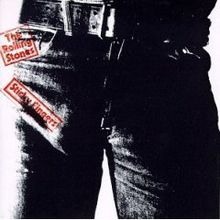Fact #61695
When:
Short story:
 The Rolling Stones release their new album Sticky Fingers, which features a cover designed by Andy Warhol, in the UK.
The Rolling Stones release their new album Sticky Fingers, which features a cover designed by Andy Warhol, in the UK. Full article:
STICKY FINGERS BY THE ROLLING STONES
by Johnny Black
The first album on the Stones own label, Sticky Fingers found them digging ever deeper into rootsy veins of Americana, with bohemian, good-vibes producer Jimmy Miller at the helm. The hit single, Brown Sugar, defines the sloppy rock groove of the entire proceedings, but guitarist Keith Richards’ increasing use of the Open G tuning he had learned from Ry Cooder adds much swampy ambience and a country feel.
In some ways, it’s a grab-bag of tracks recorded over the preceding two years, some on the newly built Stones Mobile truck, parked outside Mick Jagger’s country home, Stargroves, others at their favourite London studio, Olympic, and still others in Muscle Shoals, in search of authentic Southern accents. Despite this, the album sounds remarkably coherent, with tracks seeming almost to merge into each other.
The album’s extraordinary sleeve, however, probably attracted more attention than its music. Shot by Andy Warhol who had previously devised the peelable banana cover for the Velvet Underground, this one featured a grainy black and white close-up of a jeans-clad groin into which a fully functioning metal zipper was inserted. The Stones were presumably sniggering up their sleeves at the thought of countless female fans enjoying the vicarious little thrill of unzipping what they assumed to be Jagger’s jeans, unaware that the groin in the photograph belonged to gay icon Joe Dallesandro. As a sales-boosting gimmick, it was a stroke of genius but, in practice, the zipper tended to rip the cover of whichever album it was shelved alongside.
(Source : Johnny Black, first published in the book Albums by Backbeat Books, 2007)
Tweet this Fact
by Johnny Black
The first album on the Stones own label, Sticky Fingers found them digging ever deeper into rootsy veins of Americana, with bohemian, good-vibes producer Jimmy Miller at the helm. The hit single, Brown Sugar, defines the sloppy rock groove of the entire proceedings, but guitarist Keith Richards’ increasing use of the Open G tuning he had learned from Ry Cooder adds much swampy ambience and a country feel.
In some ways, it’s a grab-bag of tracks recorded over the preceding two years, some on the newly built Stones Mobile truck, parked outside Mick Jagger’s country home, Stargroves, others at their favourite London studio, Olympic, and still others in Muscle Shoals, in search of authentic Southern accents. Despite this, the album sounds remarkably coherent, with tracks seeming almost to merge into each other.
The album’s extraordinary sleeve, however, probably attracted more attention than its music. Shot by Andy Warhol who had previously devised the peelable banana cover for the Velvet Underground, this one featured a grainy black and white close-up of a jeans-clad groin into which a fully functioning metal zipper was inserted. The Stones were presumably sniggering up their sleeves at the thought of countless female fans enjoying the vicarious little thrill of unzipping what they assumed to be Jagger’s jeans, unaware that the groin in the photograph belonged to gay icon Joe Dallesandro. As a sales-boosting gimmick, it was a stroke of genius but, in practice, the zipper tended to rip the cover of whichever album it was shelved alongside.
(Source : Johnny Black, first published in the book Albums by Backbeat Books, 2007)